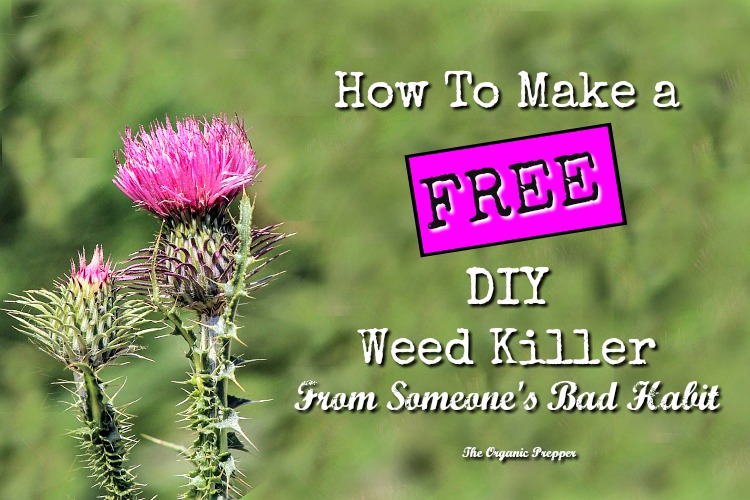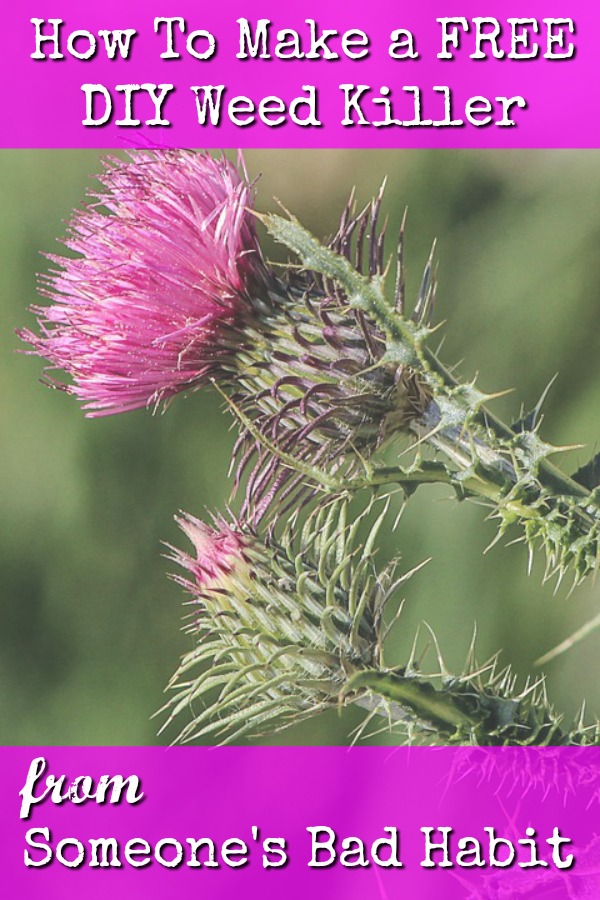If you're new here, you may want to subscribe to my RSS feed. Thanks for visiting!
By Daisy Luther

As happily organic as we all try to be, sometimes we have to deal with noxious weeds. While strong white vinegar will get rid of many of these weeds, occasionally we have to pull out the big guns. Instead of turning to Monsanto’s Round-Up, you can use someone’s bad habit to make your own DIY weed killer – and it’s free.
A quick word on vinegar weed killers: a lot of people try them and say that they don’t work. For a vinegar to be effective as a weed killer, it has to be highly concentrated – 10% or more. This is a 30% vinegar that can be used when serious vinegar is needed but it ends up being a lot more pricey than the DIY I’m about to show you.
A noxious weed is one that has been designated by an agricultural authority as harmful to crops, ecosystems, humans, or livestock. These plants tend to grow aggressively and multiply quickly, often invading and area and spreading through it rapidly, leaving ecological destruction in their wake. As well, some noxious weeds are either harmful or poisonous to people and animals.
Here’s how to make a frugal DIY weed-killer.
Cigarette smoking is a nasty habit but many people still do it. If you happen to have visiting smokers, they can help keep your pathways and patios pristine and weed free. If, like me, you banish smokers to your back yard but still get left with the problem of disposing of all those butts tossed into a sand-filled pot or an ashtray, you can make a slight change and put those nasty butts to a good use.
Swap out the ash tray for a lidded bucket with a few inches of water in the bottom and get them to throw their butts into the bucket. Make sure you keep this out of the reach of children and animals because the liquid contents are deadly if ingested.
The water will turn a nasty-looking orange-brown colour very quickly. This is the nicotine leaching out of the butts. The longer they are in there the more nicotine will leach out into the water.
As time goes on add more water to your bucket until it is about half full. You’re basically making the nastiest tea imaginable. After a week or so of steeping you’re ready to go. (You can leave it steeping as long as you like if smoking visitors are rare.)
Here’s how to make the weed killer. Make sure you wear rubber gloves.
- Cover the top of the bucket with something to catch the butts, a pair of pantyhose works well stretched and secured over the top of the bucket.
- Drain the liquid into another bucket and discard the fabric containing the butts directly into the trash.
- Take your bucket of liquid and a small container – Dana, the reader sharing this tip, uses a turkey baster specific to this purpose.
- Chop the head off the weed and individually target those that dare to invade your drive or patio.
Nicotine weed killer is very potent. It will lay waste to even thick weeds and brambles on land that needs to be cleared before it can be improved and put to good use. For thick stemmed weeds and brambles cut the stems as near to the ground as you can without getting ripped to pieces and put the solution directly into the stem.
That’s it. Easy and it won’t cost you a penny.
Now, some caveats.
Please use this responsibly and protect pets, children, other plants, and wildlife.
- Nicotine is deadly to plant material. This is why I suggest it for use on patios and drives. You’ll want to keep it well away from your lawn and vegetable garden.
- Use it on a dry, sunny day. You don’t want a rainfall washing it into the soil.
- Nicotine is deadly to bees and birds. This is why I suggest targeting individual weeds rather than broadcast spraying. Always, always cut the tops off the weeds. Cut them down as low to the ground as possible before treating, so that the birds and bees are less likely to be attracted to the plant. The plant matter you cut down can be burned unless it is poison ivy or oak – never burn poison ivy or poison oak.
- Nicotine is deadly to animals and children. Keep them away from the area where you’ve used it.
You can go a step further and cover the weeds that you’ve poisoned. This is what I do.
When I was in California, we got these occasional horrible Scotch thistles that can grow to over 8 feet and are covered in little spines that are excruciatingly painful when touched. Cutting them down and digging them up was not enough to get rid of them – they’d come right back and bring their friends. After chopping them down, adding the weed killer right into the center of the stem, I tied a plastic grocery bag tightly around the plant to keep livestock, pets, birds, and bees away.
For other thrifty self-reliance ideas:
Be sure to sign up for the newsletter HERE and check out the following articles:
- Dirt Cheap: The Best Frugal Gardening Ideas on the Internet
- Self-Reliance Strategies for Small Spaces, Temporary Locations, and Rentals
- Resources for Setting Up a Prepper’s Homestead Quickly and Inexpensively
- Learn Exactly How to Grow 25 Vegetable Garden Favorites for Maximum Harvests
- Everything You Need to Know About Raising Baby Chicks on a Budget
Do you have any other super-frugal solutions for killing noxious weeds?
Please share your tips in the comments section below.
Thanks to OP reader Dana G. for sharing her frugal weedkiller tip.
















Wow, so much anti smoking agenda and bad info in this article. Very poorly written
Smoking IS unhealthy. In other news, the Earth is round.
Learn about the edible weeds. Eat them first before killing them. I add them to smoothies.
Came here looking for what I got, a cheap easily sourced weed killer. Got a batch going now. I think it will work fine.